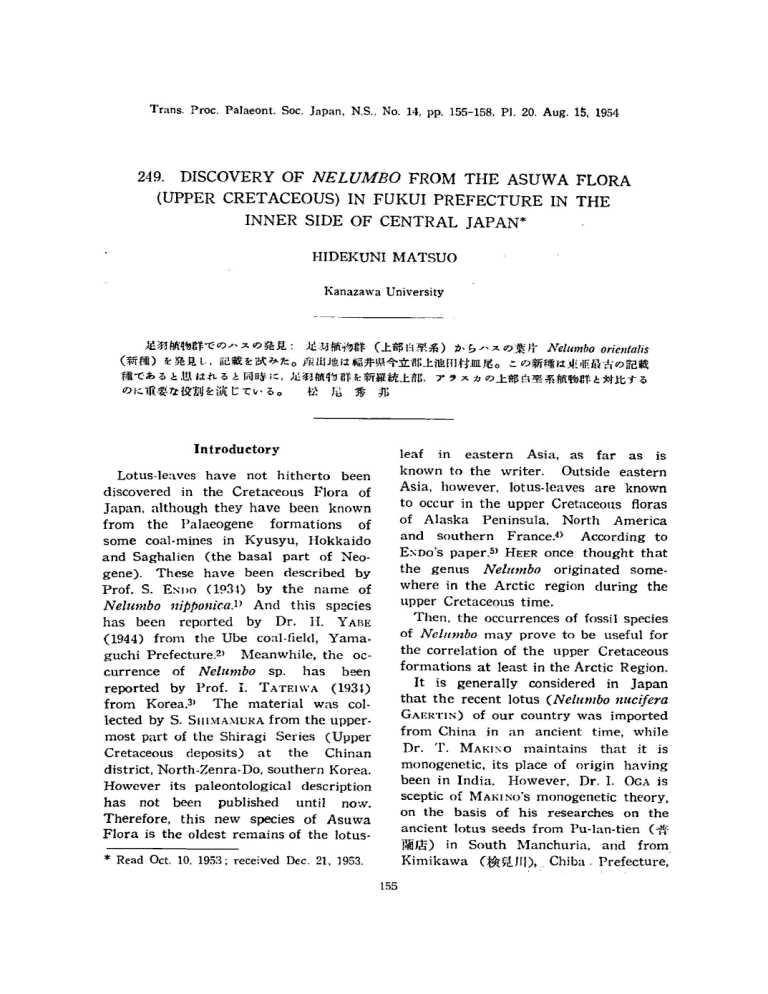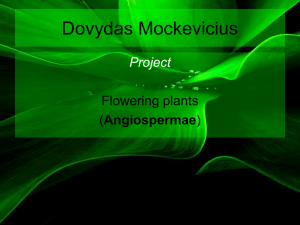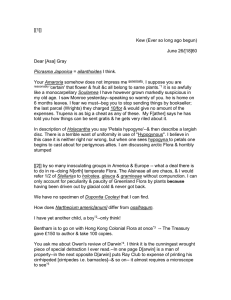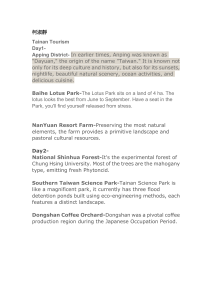Trans. Proc. PaNeont Soc. Japan. RS., No. 14, pp. 155
advertisement

Trans. Proc. PaNeont Soc. Japan. RS., No. 14, pp. 155-158,Pl. 20. Aug. 15, 1954 249. DISCOVERY OF NELUMBO FROM THE ASUWA (UPPER CRETACEOUS) IN FUKUI PREFECTURE INNER SIDE OF CENTRAL JAPAN* FlIDEKUNI FLORA IN THE MATSUO Kanazawa University 足 弱植 物 群 で の ハ ス の 発 見:足弱 植物 群(上 部白〓 系)か らハ ス の葉 片Nelumbo orientalic (新種)を 発 見し,記 載 を試 み た。産出 地 は福 井 県合立 郡 上 池 田 村 皿尾 。 こ の新種 は東亜 最古 の 記 載 (種て あ る と思 は れ る と同時に,足弱植物群を 新 羅統上部,アラ ス カの上 部白〓系植物群と 対 比 す る のに重 要な役 割 を演 じてい る。 松尾 秀 邦 Introductory leaf Lotus-leaves have not hitherto been discovered in the Cretaceous Flora of to Oct. 10. 1953: received Dec. 21. the Alaska and France4) the Cretaceous Then, of the the correlation It of at generally the recent GAERTIN) of from China Dr. T. our in ancient 155 in the the was lotus seeds South imported time, origin Dr. I. OGA on Chiba is and , the Pu-lan-tien Manchuria, (ŒŸŒ©•ì), is theory researches from it having monogenetic his while that of However, of Japan nucifera maintains basis Region. in ancient place for Cretaceous Arctic country IVIrout.co's species useful (Nelumbo an India. the Kimikawa upper in be considered its of some- fossil the MARINO in sceptic of to lotus monogenetic, been that during prove least is that to thought time. may formations floras America region occurrences Nelunthe known originated Arctic is According once Nelumbo in upper are North HEER genus as eastern Cretaceous Peninsula, paper.5) where 1955 upper southern the far Outside lotus-leaves in ENoo's as writer. however, of on Asia, the occur ) Read eastern to Asia, Japan, although they have been known from the l'alaeogene formations of some coal-mines in Kyusyu, Hokkaido and Saghalien (the basal part of Neogene). These have been described by Prof. S. ENDO (1931) by the name of Nelumbo nipponica.1) And this species has been reported by Dr. II. YAIIII (1944) from the Ube coal-field, Tama. guchi Prefecture2) Meanwhile, the occurrence of Ncluntbo sp. has been reported by Prof. 1. TATEI VA (1934) from Korea3) The material was collected by S. SIIIMAMURAfrom the uppermost part of the Shiragi Series (Upper Cretaceous deposits) at the Chinan district, North-Zenra-Do, southern Korea. However its paleontological description has not been published until now. Therefore, this new species of Asuwa Flora is the oldest remains of the lotus* in known (ft from •¬“X Prefecture, 156 Hidelcum in the vicinity of Tokyo, which are believed to be ca. 2,000 years old. According to. his opinion the ancient lotus and therecent Neltonbo are synonymous : taking the occurrences of lotus in the Japanese Islands and Manchuria where ancient forms are known origin, instead of the monogenetic in India. The oldest lotus of the Far East new species for which the writer is a pro- posed the name will be described and Neltanbo below. orientalis MATSuo Geological Notes The fossil leaves dealt with in this note were discovered in the abandoned debris of a closed mine (activity in 1943-46), near the village of Sarao, Kami-ikeda-Mura, Imadate-Gun, Fukui Prefecture, These debris were derived without doubt from a formation of alternating beds with fine tuffaceous sandstone and some dark coloured calcareous shale. The rock specimen containing three leaves of Nelumbo orientalis nov. sp. The writer is of opinion that the Tetori Flora should he limited within the iteshiro Group,7) because this group is a deposit of a land facies, and its basal part contains boulders of rocks of the lower horizon of the Karol-on Group which is of the marine facies. The correlation of the bed with the Asuwa Flora with the Taishu Group of Is.. Tsushima is based on the fact that the rock characters of the Sarao formation resembins those of this group, containing a tuffitedike rock-and a tuffaceous coarse sandstone (this sandstone seems to coincide with TATEIwn's " Bed. intercalated by quartzporphyry"). *福 井 県 今 立 郡 上 池 田村 皿 尾 . Discovery of Neletmbo from the Asuwa Flora (Upper Cretaceous) together with Sequoian twigs is a compact tuffaceous shale, which belonging to the Sarao formation** of the upper Cretaceous deposits of Hokuriku region, on the Japan Sea side of Central Japan. These upper Cretaceous deposits contain abundant plant fossils, as the writer in cooperation with S. BMA, reported to the Geological Society of Japan on the occasion of its 60th Anniversary,6) its flora having been referred to consist, beside the new Nelumbo, of CladoPhlebis, Sagenopleris, Ossnunda, (Idlelasequoia like twig). Tumion Sequoia, Nilssonia. Ginkgoiles, Populus, Pltyllites, etc. On that occasion we introduced the name of the Asuwa Flora for denoting the occurrence of the plant fossil bed. This flora is distinguished from the Tetori Flora. and corresponds to the upper Cretaceous Flora of Alaska. Concerning the Asuwa Flora, the writer wishes to report in another occasion. Stratigraphical relations of the upper Cretaceous of the Inner side of Japan, South Korea and Alaska Peninsula are suggested to be as followed. Description Family of Species Nympliaceae Nelumbo orienlalis, nov. sp. dr. feeeenbo ISempa (HoLLcR) HoLLICK (1906); US. Geol. Surrey Monograph L, p. Si. Pls. XHI-XVI cfr. N. nipponica ENDO (1934): Japan. Jour. Geot. & Geogr. Vol. XI. p. 255-258, XXXVI-XXXVIII. r. N. dowsoni cf ROLLICK. BROWN (1936); U.S. Geol. Surrey Prof. Paper 189-1, P. 250. Pl. 48. fig. 11. r. N. nipponica ENDO,cfYABE(1944): Proc. Imp. Acad. Tokyo. Vol. XX. p. 725-731, fig. 3 **皿 尾絜 層 157 Two leaves on a slab of shale, leaves subotbicular, 12cm in diameter, margin slightly undulate. Petiole stout suggesting to be 0.4-0.5 cm wide in compressed state. Primary ribs assumed to be 22 and 26, respectively, in number,radiating from center of leaf, and forking uniformly and dichotomously two or three times with angles of 30 to 50 degrees; first fork usually at about a half of the length. Areolation fine but distinctly impressed, commonly forming numerous regular hexagonal and pentagonal meshes and rarely rhombic forms. Fossil species of Nelumbo is characterized chiefly on the basis of differences in the number of radial veins. But in recent species can not be distinguished from one another by the following reason; according to BROWS'sdiscussion on the two recent species of Netumbo, the number of veins in the American lotus (Nelumbo !aka) varies from 18 to25, with 22 as an average ; while in the East Indian species (N. nucifcra) the average is 20. Then, Dr. I. OGA shows that the vein number of N. nucifera of Japan varies from 19 to 25, 21 being the dominant number, followed by those with 22. Thus he is inclined to disregard the number of radial veins as well as the diameter and the form of leaves, as specific characteristics. The writer, however, agrees to BROWN'Sopinion that, as fossils are formed and found by chance, and the material is scanty, the difference in the number of veinlets would be useful for specific characterization of fossils. This new species has a somewhat more numerous radial ribs than the other fossil species, because Nelumbo nipponica is assumed to have 21, N. dowsoni has 18, and the other American fossil species is assumed to have 11 to 18 veins. Then N. nipponica is closely 158 Hidekuni related to and it lated the recent appears to species to the be rather American interesting fact closely related fossil species than closely to is an lotus the the re- This American to advices and suggestions given to him in this study. To Prof. I. TATEIWAof the Tokyo University and to Dr. I. OGA, the President of the Lotus Research Society in Japan, the writer is indebted for knowledge on the fossil Korean lotus, and the ancient and recent lotus, respectively: To Prof. I. HAYASAKA of the Hokkaido University thanks are due to his kind criticism and realing of manuscripts. nucifera, lotus. that more N. MATSUO Far is Eastern American fossil species. Moreover, be the smaller nipponica of the of type, 60 but senia N. dowsoni small determined leaves to Locality: be 600 Sarao, of m References single having the The in- species small west Bra- a cm. Korean a was size. from the village of Imaclate.Gun, Prefecture. 35•‹51'40"N. L Geological Long. horizon Flora Collector are Eami-ikeda-Mura. Fukui .at the of 4.4 of larger considers species, south recorded a BROWN diameter N. dia- is assumes Cretaceous maximum to as maximum tienzpii However, these upper N. looks species, the cm, size. leaves other measures meter that size than (upper : Depository If. : MATSUO. University. July Asuwa No. under (upper 12, 1953. Institute Reg. specimen, formation, Cretaceous). Geological 10018b 136•‹21'29"E Sarao of Kanazawa GKZ10018a surface) (Type- and No. GU, surface). Acknowledgments The sincere Gelogical MASAMUNE Kanazawa writer wishes thanks to to Prof. K. Institute, of the University, express and of Prof. Biological for his OZAKI the G. 1) ENDO,S. (1933-34), A New Species of Nelumbo from the Palacogene of Japan. JaPon. Journ. Geol.& Geogr. Vol. XI, p. 255-258. 2) YABE.IL (1944)PalaeoceneAge of the coal Formationof the Ube Coalfield,Yamaguchi Prefecture. Proc. Imp. Acad. Tokyo. Vol. XX, p. 727, Fig. 3. 3) TATIOWA.1. (1933-34), Cretaceous Flora of Tsushima, .Japan.Japan. Joist.Geol. Geogr., Vol.XI, p. 189-209. 4) PoTosifi. IL (1921), Lehrbuch der Palaobotanik p. 369. 5) ENDO, S,(1933-34) Op. cit. p. 256. 6) MATSUO,H. & KIDA,S. (1953), On the Occurrenceof the Asuwa late Cretaceous Flora in the Upper Asuwa River in Fukui Prefecture and a Note on the Angiosperm Series. Jour, Geol.Soc. Japan, Vol.LIX, no. 694, p. 324. 7) MATSUO,H. (1953), The Bearing of the so-called Tetori Series. Jour. Geol. Soc. Japan, Vol. LIX, NO.694, p. 357. Institute, their valuable Plate Netumbo 20 orientalis, nov sp MATSUO ;Nelumbo from the Asuwa flowa PLATE 20


